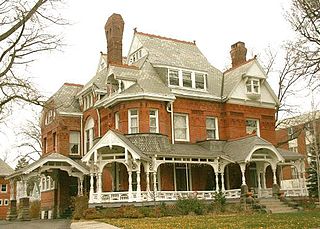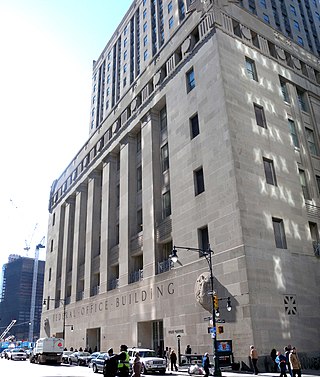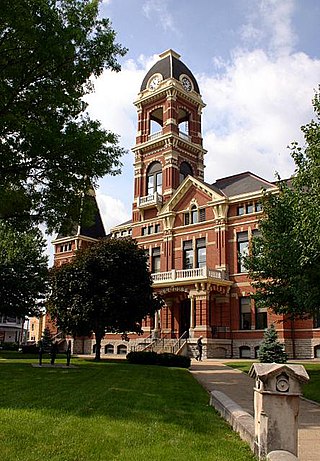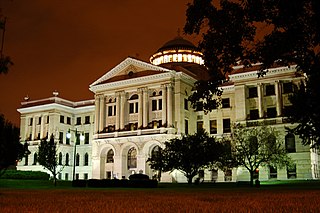Samuel M. Plato (1882–1957) was an American architect and building contractor who is noted for his work on federal housing projects and U.S. post offices, as well as designing and building other structures in the United States such as private homes, banks, churches, and schools. During World War II, the Alabama native was one of the few African-American contractors in the country to be awarded wartime building contracts, which included Wake and Midway Halls. He also received contracts to build at least thirty-eight U.S. post offices across the country.

The Old West End is a historic neighborhood in Toledo, Ohio and is considered to be "the largest neighborhood of late Victorian, Edwardian, and Arts & Crafts homes east of the Mississippi." The south end of the neighborhood is bounded by the Toledo Museum of Art and the eastern edge by churches of many denominations on Collingwood Boulevard. The area has homes varying in area from 1,200 to 10,000 square feet (930 m2).

Sidney Rose Badgley was a prominent start-of-the-20th-century Canadian-born architect. He was active throughout the United States and Canada, with a significant body of work in Cleveland.

The Religious Structures of Woodward Avenue Thematic Resource (TR) is a multiple property submission to the National Register of Historic Places which was approved on August 3, 1982. The structures are located on Woodward Avenue in the cities of Detroit and Highland Park, Michigan.

The Woodward Avenue Baptist Church was a Church located at 2464 Woodward Avenue in Detroit, Michigan. It was listed on the National Register of Historic Places in 1982, but was destroyed by fire in 1986 and delisted in 1988.

Church Street and Trinity Place form a single northbound roadway in Lower Manhattan, New York City. Its northern end is at Canal Street and its southern end is at Morris Street, where Trinity Place merges with Greenwich Street. The dividing point is Liberty Street.

St. Louis Street Missionary Baptist Church is a historic African American church in Mobile, Alabama. It was added to the National Register of Historic Places on October 8, 1976, due to its architectural and historic significance.

Emmanuel Baptist Church is a Baptist megachurch in the Clinton Hill neighborhood of Brooklyn, New York, on the northwest corner of Lafayette Avenue and St. James Place, affiliated with the American Baptist Churches USA. The attendance is 2,200 people. The senior pastor is Anthony L. Trufant.

Albert C. Nash (1825-1890) was an American architect best known for his work in Milwaukee and Cincinnati.

Harry Wilcox Wachter was an American architect in Toledo, Ohio. He was the local architect involved in the design and construction of the Toledo Museum of Art, working with Edward B. Green's Buffalo, New York firm on the Greek revival building. Wachter and his firms are also credited with designing several churches including First Presbyterian Church and historic buildings such as Bronson Place.

Frank Chamberlain Clark (1872–1957) was an American architect active in Southern Oregon. Many of his works are listed on the National Register of Historic Places (NRHP).

Povey Brothers Studio, also known as Povey Brothers Art Glass Works or Povey Bros. Glass Co., was an American producer of stained glass windows based in Portland, Oregon. The studio was active from 1888 to 1928. As the largest and best known art glass company in Oregon, it produced windows for homes, churches, and commercial buildings throughout the West. When the firm was founded in 1888, it was the only creative window firm in Portland, then a city of 42,000 residents.
Henry Wildhagen was one of northern Wisconsin's best-known architects at the turn of the 20th century.

Union Park Congregational Church and Carpenter Chapel is a historic church building at 60 N. Ashland Blvd. on the Near West Side of Chicago, Illinois. The chapel is named after Philo Carpenter, a deacon, a co-founder of the congregation and of the Chicago Theological Seminary, and an early donor of the original church who was also a noted abolitionist and the city's first druggist. The two buildings are considered as a unit; together, they are a Chicago Landmark and an Illinois Historic Landmark and are listed on the National Register of Historic Places. The church building is currently occupied by the First Baptist Congregational Church, whose official mailing address is 1613 W. Washington Blvd. in Chicago.
John W. McKecknie (1862–1934) was an American architect working in Kansas City, Missouri, who applied the principles of reinforced concrete in the construction of commercial structures clad in a repertory of classical motifs. He produced designs for some 120 commercial buildings, residences and apartment blocks, establishing the monumental character of West Armour Boulevard with more than a dozen colonnaded apartment blocks. Several of his structures are now registered in the National Register of Historic Places, and others contribute to their Historic District designations.

Hubbell & Benes was a prominent Cleveland, Ohio architectural firm formed by Benjamin Hubbell (1857–1935) and W. Dominick Benes (1867–1953) in 1897 after the pair departed from Coburn, Barnum, Benes & Hubbell. Their work included commercial and residential buildings as well as telephone exchange buildings, the West Side Market and Cleveland Museum of Art. Before teaming up, they worked for Coburn and Barnum. Benes was Jeptha Wade’s personal architect and designed numerous public buildings, commercial buildings, and residences for him including the Wade Memorial Chapel.

David Leander Stine was an architect in Toledo, Ohio. His work includes the Brumback Library, Lucas County Courthouse and Jail (1897) and several homes in the Old West End neighborhood of Toledo including the Edward D. Libbey House (1895).

The Ashland Downtown Historic District in Ashland, Oregon is a 32.2 acres (13.0 ha) historic district which was listed on the National Register of Historic Places in 2000. The district is roughly bounded by Lithia Way and C Street, Church, Lithia Park and Hargadine and Gresham Streets.
Vernon Redding was an architect in Mansfield, Ohio. He designed the Ashland County Courthouse (Ohio), Huron County Courthouse and Jail (1913) and one or more buildings in Center Street Historic District. He also designed Mansfield's Carnegie library built in 1908. Several buildings he designed are listed on the National Register of Historic Places (NRHP).

The Tifton Residential Historic District, in Tifton, Georgia, is a historic district which was listed on the National Register of Historic Places in 2008.




















